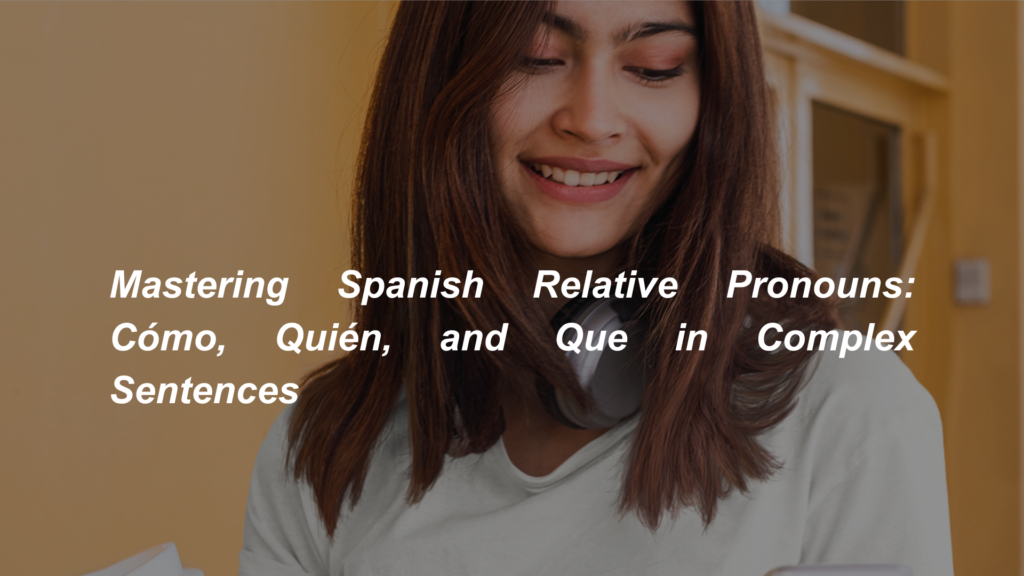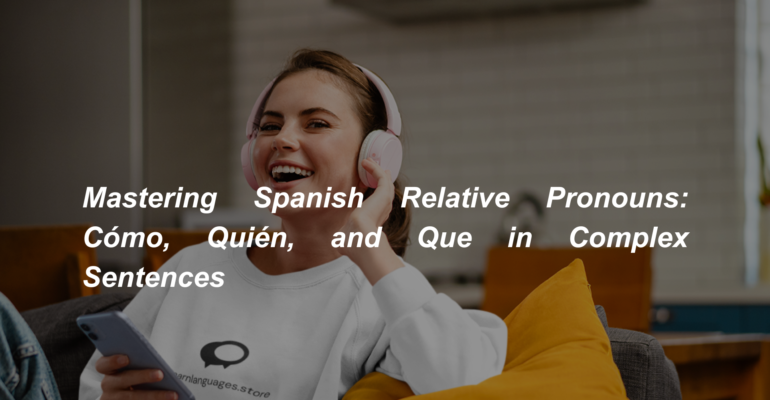Mastering Relative Pronouns in Spanish: Cómo, Quién, and Que in Complex Sentences
Mastering Relative Pronouns in Spanish: Cómo, Quién, and Que in Complex Sentences
Estimated reading time: 8 minutes
Introduction
When learning Spanish, understanding relative pronouns is crucial for forming complex sentences. These pronouns—such as cómo (how), quién (who), and que (that/which)—help connect ideas, adding depth and clarity to your communication. For learners fluent in both Hindi and English, Spanish relative pronouns may feel familiar, yet their specific usage and placement require some practice.
In this blog post, we’ll explore the role of cómo, quién, and que in complex Spanish sentences. We’ll compare how these pronouns function in Spanish versus English and Hindi to help learners see the connections across languages. By the end, you’ll have a clear understanding of how to use these relative pronouns in various contexts, including the exceptions and irregularities you need to be aware of.

What Are Relative Pronouns?
Relative pronouns are used to link clauses together, providing additional information about a subject, object, or action. They allow us to create more complex, descriptive sentences. In English, we use words like “who,” “which,” and “that.” In Hindi, similar structures exist with जो (jo) or कौन (kaun) to indicate relationships between ideas.
- In English, relative pronouns include “who,” “whom,” “that,” “which,” and “how.”
- In Hindi, relative pronouns like जो (who/that), कौन (who), and कैसे (how) are commonly used.
- In Spanish, the most common relative pronouns are que (that/which/who), quién (who/whom), and cómo (how).
Let’s break down the use of each in more detail.
1. Que: The Most Common Relative Pronoun
The relative pronoun que is the most frequently used in Spanish. It can mean “who,” “whom,” “which,” or “that”, depending on its context. It’s a versatile word that connects ideas within complex sentences.
Usage of Que:
- Que refers to people, objects, and things.
- It introduces a dependent clause and provides additional information about a noun in the main clause.
Examples:
- El libro que leí es interesante.
(The book that I read is interesting.)
Hindi: वह किताब जो मैंने पढ़ी, रोचक है। - La persona que conocí era amable.
(The person who I met was kind.)
Hindi: वह व्यक्ति जो मैंने मिला, दयालु था।
Comparison with English: In English, que functions like “who,” “that,” or “which,” depending on the sentence. In both Spanish and English, it introduces a clause that describes or identifies a noun.
Comparison with Hindi: In Hindi, जो functions similarly, linking clauses together to add detail about the subject or object.
2. Quién/Quienes: Referring to People
The relative pronoun quién (plural: quienes) is used specifically to refer to people. It can mean “who” or “whom” and is often used after prepositions or in clauses where the subject or object is a person.
Usage of Quién/Quienes:
- Quién is used when referring to a singular person.
- Quienes is used for plural subjects.
Examples:
- La mujer a quien conocí es doctora.
(The woman whom I met is a doctor.)
Hindi: वह महिला जिससे मैं मिला, डॉक्टर है। - Los estudiantes, quienes trabajaron duro, aprobaron el examen.
(The students, who worked hard, passed the exam.)
Hindi: छात्र, जिन्होंने कड़ी मेहनत की, परीक्षा पास कर ली।
Comparison with English: The pronoun quién/quienes is used like “who” or “whom” in English, depending on whether it refers to the subject or object in the clause. In English, “who” is used for subjects, and “whom” is for objects, whereas in Spanish, quién or quienes fits both roles, depending on context.
Comparison with Hindi: In Hindi, कौन (kaun) or जिससे (jisse) functions similarly when referring to people, but the context helps determine the exact form.
3. Cómo: Describing Manner or Method
The relative pronoun cómo translates to “how” in English and कैसे (kaise) in Hindi. It is used to describe the manner or way in which something happens. Cómo introduces clauses that explain or describe methods or processes.
Usage of Cómo:
- It explains the manner in which something happens.
Examples:
- No sé cómo lo hizo.
(I don’t know how he did it.)
Hindi: मुझे नहीं पता उसने यह कैसे किया। - Explícame cómo llegaste aquí.
(Explain to me how you arrived here.)
Hindi: मुझे बताओ कि तुम यहाँ कैसे पहुँचे।
Comparison with English: In English, cómo works just like “how” when referring to methods or explanations. It’s used to connect two clauses, just like in Spanish.
Comparison with Hindi: In Hindi, कैसे (kaise) plays the same role, connecting clauses to describe the method or process by which something occurs.
-
Product on sale
 French DELF B1
French DELF B1₹32,600.00
₹36,300.00
Grammar Pattern Breakdown
Que:
- Form: que + verb (depending on subject)
- Usage: Describes people, objects, or things. Used in restrictive or non-restrictive clauses.
- Examples:
- La casa que compramos es grande.
(The house that we bought is big.)
- La casa que compramos es grande.
Quién/Quienes:
- Form: quién/quienes (often following prepositions or commas)
- Usage: Refers specifically to people, either as the subject or object of the clause.
- Examples:
- Los amigos con quienes salimos anoche son simpáticos.
(The friends with whom we went out last night are nice.)
- Los amigos con quienes salimos anoche son simpáticos.
Cómo:
- Form: cómo + verb
- Usage: Explains manner or method.
- Examples:
- Cuéntame cómo lo resolviste.
(Tell me how you solved it.)
- Cuéntame cómo lo resolviste.
Exceptions and Special Cases
As with most grammar rules, there are some exceptions or irregular uses of these relative pronouns in Spanish.
1. Omitting Que in Informal Speech
In informal conversations, que is sometimes omitted when it is clear from the context.
Example:
- La película vi ayer fue interesante.
(The movie I saw yesterday was interesting.)
Standard Form: La película que vi ayer fue interesante.
2. Use of El Que, La Que, Los Que, Las Que
When que needs to be more specific or formal, especially in more formal writing, it is often used with the definite articles el, la, los, or las depending on the gender and number of the noun.
Example:
- El libro del que te hablé está en la mesa.
(The book that I talked to you about is on the table.)
3. Use of Cuyo/Cuya (Whose)
The relative pronouns cuyo/cuya (and their plural forms cuyos/cuyas) are used to indicate possession, equivalent to “whose” in English.
Example:
- El niño cuyo perro está perdido está triste.
(The boy whose dog is lost is sad.)
Hindi: वह लड़का जिसका कुत्ता खो गया है, उदास है।
Example Sentences
Here are six example sentences using que, quién, and cómo, along with their translations in English and Hindi:
- Spanish: La persona que me llamó ayer era mi primo.
- English: The person who called me yesterday was my cousin.
- Hindi: वह व्यक्ति जिसने मुझे कल कॉल किया था, मेरा चचेरा भाई था।
- Spanish: No sé cómo funciona este aparato.
- English: I don’t know how this device works.
- Hindi: मुझे नहीं पता यह उपकरण कैसे काम करता है।
- Spanish: Los niños, quienes estaban jugando, se cayeron.
- English: The children, who were playing, fell down.
- Hindi: बच्चे, जो खेल रहे थे, गिर गए।
- Spanish: Esa es la película que quería ver.
- English: That is the movie that I wanted to see.
- Hindi: यह वह फिल्म है जिसे मैं देखना चाहता था।
- Spanish: Quiero saber cómo llegaste tan rápido.
- English: I want to know how you arrived so quickly.
- Hindi: मैं जानना चाहता हूँ कि तुम इतनी जल्दी कैसे पहुँचे।
- Spanish: No recuerdo quién me lo dijo.
- English: I don’t remember who told me that.
- Hindi: मुझे याद नहीं है किसने मुझे यह बताया।
Frequently Asked Questions (FAQs)
Conclusion
Mastering relative pronouns like que, quién, and cómo is key to forming complex sentences in Spanish. By understanding how these words work and comparing them to their Hindi and English counterparts, learners can confidently build more detailed and expressive sentences. The more you practice these forms, the easier they will become, helping you move closer to fluency.
Keep practicing by incorporating these relative pronouns into everyday conversations and writing, and soon you’ll find them flowing naturally!
Enhance Your Spanish Skills!
To improve your Spanish further, consider enrolling in our Spanish Course at Learn Languages Store for just Rs. 16,300. Our courses are designed to help you build a strong foundation in the Spanish language in a fun and engaging way.
Contact Us to Learn More!
For more information about our courses, feel free to reach out to us at:
Address:
330, 3rd Floor, Big Splash (Near Vashi Bus Depot),
Sector 17, Vashi,
Navi Mumbai, Maharashtra 400703
Phone: +91-9594113111
Email: services@learnlanguages.store
Don’t miss the opportunity to enhance your language skills! Sign up today and start your journey to fluency in Spanish!










